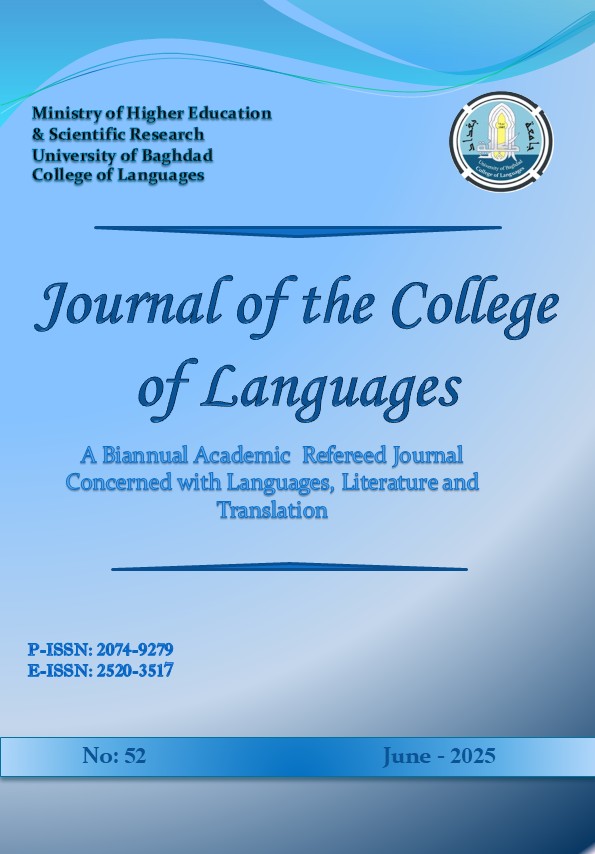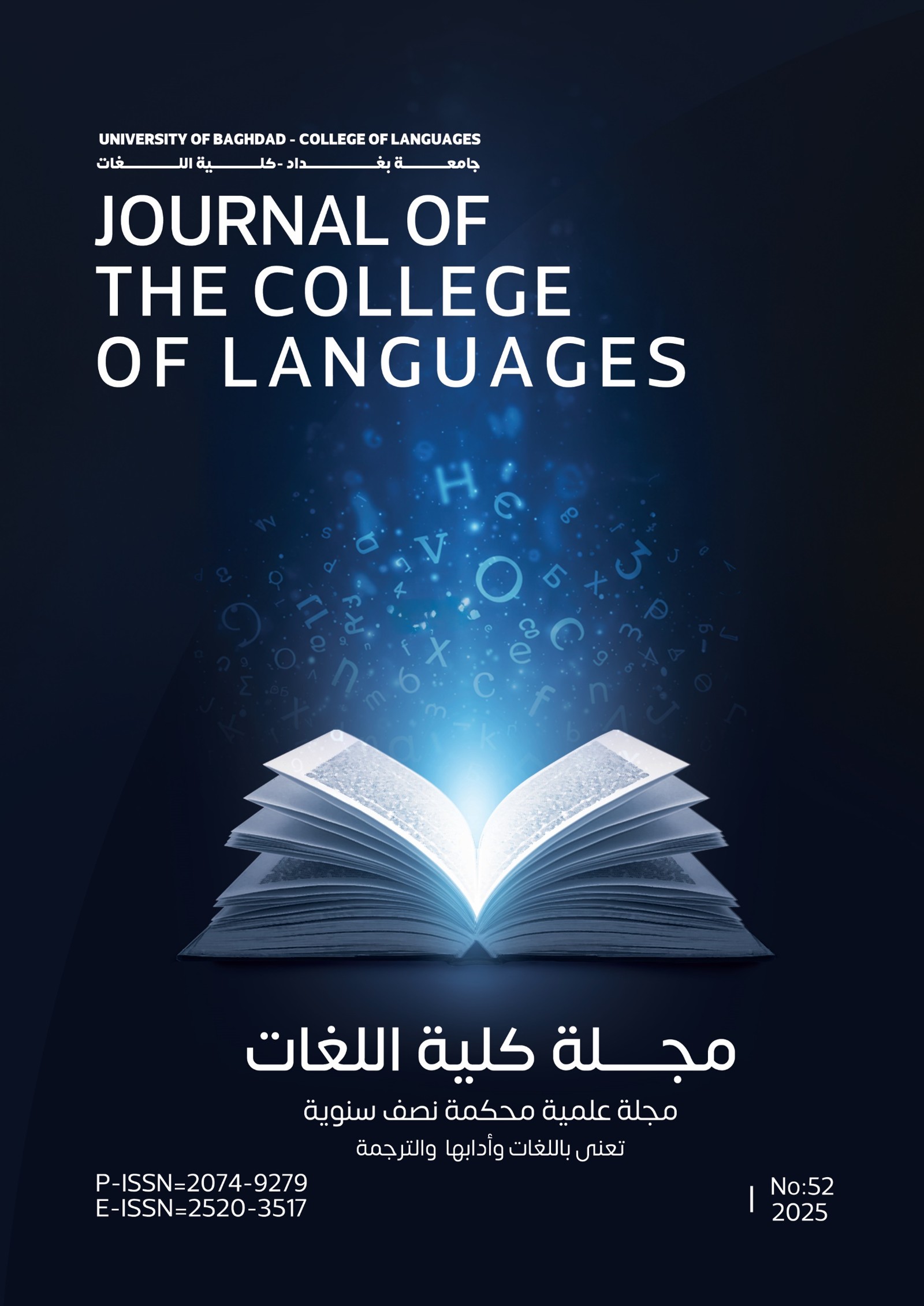The Application of Grimas's Actor Theory in Characterization of Children's Stories(A Case Study of the Short Story "The Village of Letters" by Mahmoud Shaqir)
کاربست نظریۀ کنشگر گریماس در شخصیت پردازی داستانهای کودکانه(مطالعۀ موردی داستان کوتاه قریة الحروف از محمود شقیر)
DOI:
https://doi.org/10.36586/jcl.2.2025.0.52.0269Keywords:
Narratology, Structuralism, Grimas, Village of Letters, Mahmoud Shakir, روايت شناسى, ساختارگرایی, گریماس, قریة الحروف, محمود شقیرAbstract
Narratology is one of the branchs of literary criticism that studies narratives. According to structuralists such as Grimas, stories and narrative, in their different forms, follow patterns and such patterns can be explored to achieve a better understanding of the story. Today, examining narrative works in terms of form and structure is of great importance in the field of narratology. Therefore, the authors in this study have attempted to examine and analyze the short story The Village of Letters using Grimas's model. For this purpose, after explaining the main principles of this theory, the story in question along with its factors and actors have been adapted. The findings of the study suggest that the role and function of each of the three pairs of action factors, narrative plot and main theme in the story of the Village of Letters can be discussed and criticized. By examining the underlying structure and deep structure of the narrative and action factors of the story in question, it can be seen that the character of Hasan is in complete agreement with the actor in Grimas's theory. The goal he pursues is based on persevering, not despairing, and making a creative effort to solve the problem at hand, which is considered the value object in Grimas's narrative elements. The most important factor that drives Hassan towards his goal is the lack of cooperation of the letter Ra with him when he needed it.
چکیده
روایتشناسی، یکی از شاخههای نقد ادبی است که به بررسی روایتهای داستانی میپردازد. به اعتقاد ساختارگرایانی چون گریماس، داستانها و روایتها با قالبهای مختلف خود، از الگوهایی پیروی میکنند که با کشف این الگوها میتوان به درک بهتری از داستان نایل شد. امروزه بررسی آثار روایی به لحاظ شکل و ساختار، از اهمیت به سزایی در حوزۀ روایتشناسی برخوردار است. لذا نگارندگان در این پژوهش تلاش کردهاند تا داستان کوتاه قریة الحروف را با بهرهگیری از الگوی گریماس، بررسی و تحلیل کنند. بدین منظور پس از تبیین مبانی اصلی این نظریه، داستان مورد بحث با عاملهای کنشی و کنشگران آن تطبیق داده شده است. از یافتههای تحقیق استنباط میشود که نقش و کارکرد هر کدام از سه جفت عامل کنشی، طرح روایی و درونمایۀ اصلی در داستان قریة الحروف، قابل طرح و نقد میباشد. با دقت در زیرساخت و ژرفساخت روایت و عاملهای کنشی داستان مورد بحث، میتوان دریافت که شخصیت "حسن" با کنشگر نظریۀ گریماس تطابق کامل دارد. هدفی که او دنبال میکند، مبتنی بر استقامتورزیدن، ناامید نشدن و انجام تلاشی خلاقانه برای حل مشکل پیشرو است که همان "شیء ارزشی" در عناصر روایی گریماس محسوب میشود. مهمترین عاملی که حسن را به سوی هدف خود سوق میدهد، عدم همکاری حرف "راء"، در هنگام نیازمندی اوست.
References
Ahmadi, Babak. (1992). Structure and Interpretation of Text. Tehran: Nashre Markaz.
Ann Jones, Catherine. (2012). The Way of Story: The Art and Spirit of Writing. Translated by: Mohammad Gozarabadi, Tehran: Hermes.
Dad, Sima. (2007). Dictionary of Literary Terms (Third Edition). Tehran: Morvarid
Forster, Edward Morgan. (1991). Aspects of the Novel. Translated by: Ebrahim Younesi, Tehran: Negah
Harland, Richard. (2006). A Historical Introduction to Literary Theory from Plato to Barthes (2nd ed.). Translated by: A Group of Translators. Tehran: Cheshmeh
Kabiri, Mobina. (2024). A study of fictional literature in the works of Mahmoud Shaqir, a case study of the short stories Al-Nahlat-e-Tayiba and Qaryat Al-Huruf and the novel Ana and Jomane. Master's thesis, University of Tehran
Makaryk, Irena Rima. (2005). Encyclopedia of Literary Theories. Translated by: Mehran Mohajer and Mohammad Nabavi, Tehran: Agah
Mirsadeghi, Jamal. (2015). Elements of Story (9th edition). Tehran: Sokhan
Molla Ebrahimi, Ezzat and Zahra Fazeli. (2020). Manifestations of resistance in Palestinian children's literature (the works of Mahmoud Shaqir al-Mushida), Al-Arabi magazine. Punjab University Lahore. Pakistan: No. 27, pp. 317-348.
Molla Ebrahimi, Ezzat and Fatemeh Rashidi Ravandi. (2025). Evaluation of the khutba of Motaqin Nahj al-Balagha based on the theory of Garces (Case study: Dashti's translation of this sermon), Journal of the College of Languages, No. 51, PP. 317- 338. https://doi.org/10.36586/jcl.2.2025.0.51.0317
Prince, Gerald. (2013). Narratology: The Form and Function of Narrative. Translated by: Mohammad Shahba, Tehran: Minooye Kherad
Shaqir, Mahmoud. (No Date). Qaryat Al-Huruf. (The Word file of this story was received from the author).
Scholes, Robert. (2005). An Introduction to Structuralism in Literature (2nd edition). Translated by: Farzaneh Taheri, Tehran: Agah.
Tadie’ Jean-Yves. (2000). Literary Criticism in the 20th Century. Translated by: Mahshid Nonahali, Tehran: Niloofar.
Tyson, Lois. (2009). Theories of Contemporary Literary Criticism. Translated by: Maziar Hosseinzadeh and Fatemeh Hosseini, edited by Hossein Payandeh, Tehran: Negah Emrooz.

Downloads
Published
Issue
Section
License
Copyright (c) 2025 Journal of the College of Languages (JCL)

This work is licensed under a Creative Commons Attribution 4.0 International License.







